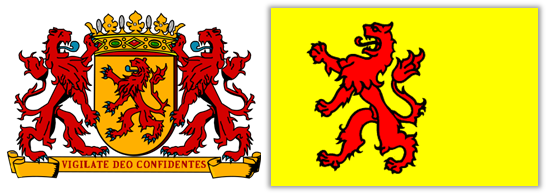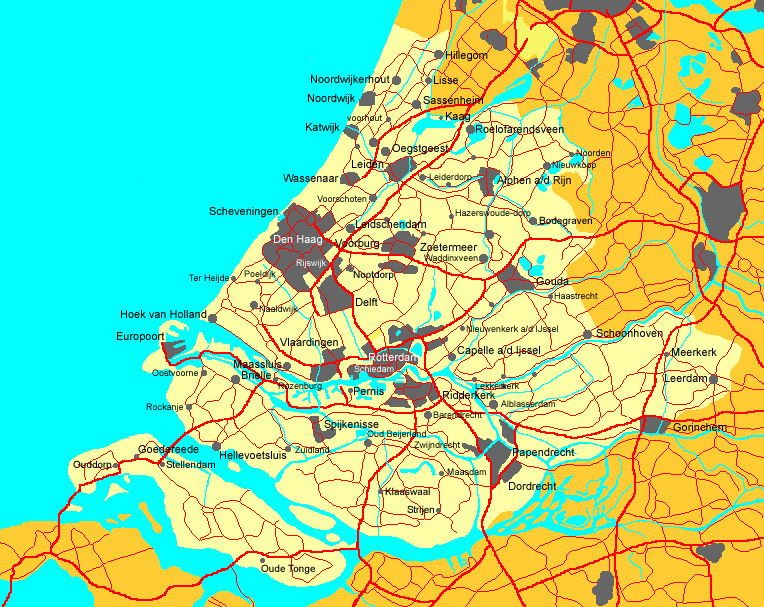Historical inhabitants of Holland, the Batavians, called their habitats Holland, that meant woodland. (Compare Saxon: Holtland and German: Holzland). This name they took also to the Rhineland. There they mingled with the Caninefates and the Frisians. Together they became the Hollanders. In the course of the history the counties Zeeland, Holland and West-Frisia gradually became one economically area. Many important decisions were signed by the “States of Holland, Sealand and Western Frisia”! Although they remained formally separate states they usually chose the same stadhouders.
After the review of the provincial divisions the former old “Holland” was divided into two provinces: North-Holland (the northern district of old Holland together with Western-Frisia) and South-Holland (the other three parts of old Holland). Further Southern-Holland lost some areas to her surrounding provinces. (In the protest anthem of Holland “We want to keep Holland” still sounds a little bit of sadness). That provincial reclassification was considered necessary to reduce the power and the dominance of Holland. (For more about Holland read: Holland & Northern-Holland).
Remark:
Many foreigners use the name Holland often as the name for all the Netherlands, so all provinces (which is incorrect). Also in the Netherlands, in older times, it was used that way but it ment in that case, all provinces except the one of the speaker.
History of Holland
According to the Romans (Pliny the Elder, ca. 20-80 AC), is it the region between two arms of the Rhine: the Helinius and Flevo. (inter Helinium ac Flevum). The Helinius was the common estuary at den Briel of the rivers Maas and Waal. The Flevus culminated in Velsen. A third estuary was the mouth of the Scheldt. The areas between these rivers were called Batavia or island(s) of the Batavians. On the Peutinger map Batavia seems to be written as Patavia. After that time the (boundaries are somewhat unclear), a shire (of Frisia?) west of the river Flevum (Vecht), later the shire “circa horas Rheni” (county Rhineland) is mentioned. In 1101 Florentius II, has the tittle comes of Hollant (Floris II, Count of Holland). So then Holland had become the name of the whole area.
The people
The west coast of the North Sea was protected by dunes. Where the land behind the dunes was relatively high (northern France and Belgium) that is still the case. Futher to the north (as far as into Denmark) these dunes are broken. That dunes became Wadden Islands and the country behind them are today the Wadden Sea. An exception is the coast where the “Hollanders” lived. They knew how to maintain the dunes. For foreigners it was characteristic for the (northern) Netherlands. Indeed, they usually arrived by ship. So she called initially only those coastal residents Hollander, but later all “Dutch” became “Hollander”. Most Hollander have now accepted that that name is also in use for people in the other provinces, but in the other provinces it is often a sensitive issue. Therefore it is not advisable to use the name Holland / Hollanders in stead of Netherlands / Netherlanders / in the other provinces. For more history see also North-Holland and Holland.
The language
English word Dutch comes from the obsolete Dutch word Diets. It meant “the people” and was used to distinguish the dutch language from (ecclesiastical) Latin. Diets as an old language (actually a collection of dialects) was spoken in the north of western Europe. (It was for example the language of the Hanseatic League). Through the influence of the Celts, who lived in southern Germany and the Alps, “Diets” changed to “Deutsch” (the German sound shift). So in addition to (Lower) Diets (from the lowlands along the German and Dutch coasts) the High Diets (in the mountains) came to live. As Martin Luther wrote his Bible in that high Diets it became, later the German standard language. The separation zone between the two “languages” in Germany, is between Bernrather- and Speyerer linië. Lower Diets (became Dutch) was standardized by the Reformed Synod of Dordrecht (Statenbijbel). Besides standard Dutch also Afrikaans and Surinamese emerged from it (the other daughter languages faded away).
The province of Southern-Holland
South-Holland is divided into: Midden-Holland, Rijnmond and the Hollandian islands & waarden. The former Noorderkwartier (simply the Gooi and the area around the cities of Amsterdam and Haarlem) was joined 150 years ago with the former West Frisia to form the new province of North-Holland. Capital of South-Holland is ‘s-Gravenhage which is usually called den Haag. The Dutch houses of government are there. That Dutch “kremlin” (the walls are gone), it is called “Binnenhof & Buitenhof”. The province has a population density of 1265 inhab. / Km.
 . Provincial coat of arms Provincial flag
. Provincial coat of arms Provincial flag
The Dutch Lions are not only supporters to the shield but they also support the counts (of Holland crown) passed to the States General. The banner says: “Attention and trust in God (Vigilate deo Confidentes).
South-Holland 1: Radio West & TV West & last news & Teletext.
South-Holland 2: Radio Rijnmond & TV Rijnmond & Last news & Teletext.
South-Holland in a birds eye & Weather & Weather warnings Southern-Holland.
Southn-Hollandian gouvernement & Southern-Hollandse Provinciale Staten.
Tourisme in South-Holland
Anthem: Southern-Holland.
-1- (The Islands and Polders)
South Holland in your pastures the grazing cattle your mills,
your dunes, beach and yout sea your ponds and lakes,
so rich in beauty your big rivers, controlled by the dikes
your fields with grain, where the wind passes
your flower fields in their colored robe!
To you, oh, South Holland, lovely country, wonderful country,
To you, oh, South Holland, I have given my hearth!
-2- (The Hague area)
South Holland, your capital so beautiful and so old
you wide The Hague, with Square and Voorhout
there are the counsels for Province and Country
there live the ambassadors and envoys.
Once the counts of Holland were hunting there resides Orange illustrious family!
To you, O South Holland, historic land, historic land,
To you, O South Holland, I have given my hearth!
-3- (Countryside)
South Holland in your cities, there flourished formerly,
the art of Crabeth, Jan Steen and Vermeer.
There were born a Rembrandt van Rijn
and brave men like Tromp and Piet Hein.
In the Princes court Orange led the fight, which ended with independence!
To you, O Holland, glorious country, glorious country.
To you, O South Holland, I have given my hearth!
-4- (Rhine delta)
South Holland in the age of modern technology,
you became an area of business and factory.
Who does not know your shipyards and heavy industry,
your industrious Westland, so full of energy.
The strongest branches on dutch tree, the trade and shipping in greater Rotterdam.
To you, O South Holland, industrious country, industrious country.
To you, O South Holland, I have given my hearth.
Anthem of the undivided Holland (translation):
-1-
We want to keep Holland our Holland proud but tiny!
We remain in love and faithful whatever its fate may be!
And those who think to threaten and intend to take us ever!
He will not get our country, we will never give up Holland!
-2-
Because fixed to our side the Dutch lion willstand!
He will never accept that Holland will perish!
As long as the lion shall bear his sword and his crown!
Will he also support us and stand next to people and throne!
-3-
Our Holland will never fall, will never perish again!
The lion is with all of us, will continue to stand with us!
The lion will keep Holland, his sword and his crown!
Faithful until death he will guard people and throne!
To add:
Modern times.
Volksdans: De Rozelaar & in Holland staat een huis. Schampeljoen Dordrecht.
Diverse Volksdans muziek. Polka Oranje Boven de vlegerd Hakke toone Rozendans
Presenteer mars “de Staten van Holland”
Den Haag (dialect) Den Haag (city-flim) Rotterdam (love song) ‘K ben aan de Maas geboren & My father was a Dutchman & Krimpenerwaard (chanty)

